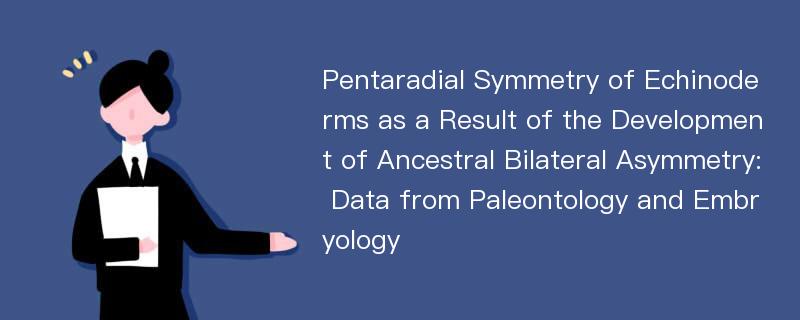
论文摘要
Five-radial symmetry(pentaradiality) is included in the echinoderm bodyplan along with a calcite stereomic skeleton and ambulacral system.Pentaradiate echinoderms appeared in the Early Cambrian at the same time, or a little earlier, with bilaterally asymmetric representatives.The five-radial Ediakaran Arkarua doesn’t belong to echinoderms and it is a bursting oxygen bubble of a cyanobacterial mat.Pentaradiality occurs initially in the ambulacral system due to the growth of the left hydrocoele around the esophagus and the polymerization of the first single ambulacrum extending from it, first to two, and then up to three ambulacra.The following two ambulacra, necessary for the appearance of pentaradiate symmetry of ambulacral system, arise by the branching of two of the previous three ones resulting from the polymerization.This process is partially reflected in the ontogenesis of recent crinoids and in the morphology of the many fossil adult echinoderms.The symmetry of the ambulacral system, as shown by paleontological data, extends to the symmetry of the skeleton, nervous and circulatory systems.Some key stages in the ontogenetic process of the development of pentaradiality(bilaterally asymmetric development of right and left coeloms, movement of the primordial mouth from the anterior to the posterior end of the settled larva(torsion), growth of the left hydrocoel around the esophagus) were absent in the ontogenesis of some "carpoid" echinoderms and therefore are not reflected in the morphology of their adult representatives.Stylophoran bodyplan reflect a bilaterally asymmetric pre-torsion developmental stage of the echinoderm symmetry.Adult morphology of the Solutans and Cinctans correspond to the developmental stage between torsion and pentaradiality1.Ctenocystoids and Ctenoimbricata can reflect the bilateral stage of the recent crinoid larva development, but it is possible that the bilateral skeleton symmetry(sometimes incomplete) of these fossils is secondary and does not reflect the symmetrical development of their coeloms, since they are not known as having the hydropores.Bilateral asymmetry of echinoderms could arise at the earliest stages of Bilateria diversification and reflect the features of bilateral symmetry emerging.Further development of asymmetry in echinoderms leads to the transformation of the left hydrocoele in the ring, the location of the posterior coeloms in stack and, ultimately, to the appearance of the pentaradiality.Five-radial symmetry is an improvement of the three-radial one, and three-radial symmetry is based on the morphogenetic mechanism of division of the bilaterally asymmetric ancestor body into the three initial metamers(anterior, middle and posterior).Findings of pre-skeletal fossils in Chinese and other Cambrian Lagerst?tten are important for the study of the origin of echinoderm asymmetry and pentaradiality as well as the formation bilaterality in Bilateria.
论文目录
文章来源
类型: 国际会议
作者: Sergey V.ROZHNOV
来源: 第一届亚洲古生物学大会—暨中国古生物学会成立90周年纪念 2019-11-17
年度: 2019
分类: 基础科学
专业: 生物学,地质学
单位: Borissiak Paleontological Institute RAS
分类号: Q915
页码: 40-41
总页数: 2
文件大小: 102k
下载量: 1
